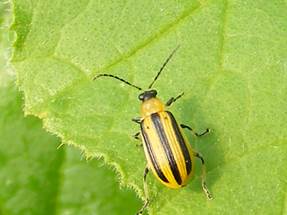Sweet Corn
European corn borer (ECB) catches have dropped to nearly nothing, and no map will appear in this edition. Feeding in NJ sweet corn plantings is highly variable, with some plantings exceeding 40%, but these occurrences are generally where there were higher moth catches during the first flight. Feeding overall is lower than expected for the first generation. Check 5 plants each in 10 random locations for a 50 plant sample. Look for “shot-hole” injury, and consider treating when the number of infested plants in a 50 plant sample exceeds 12%. As infested plants proceed to the pre-tassel stage, live larvae and damage may be found in the emerging tassels. Once plants hit full tassel, ECB larvae will move downward on the stalk and re-enter the plant near the area where ears are forming. This can result in direct injury to the ear. Growers should consider an insecticide application at the full tassel stage to target ECB larvae as they migrate downward. This application can eliminate larvae that have escaped any earlier insecticide applications.
The highest nightly ECB catches for the previous week are as follows:
| Blairstown 1 | Newton 1 |
| Calicon 1 | Sergeantsville 1 |
| Cedarville 1 | South Branch 1 |
| Centerton 1 |
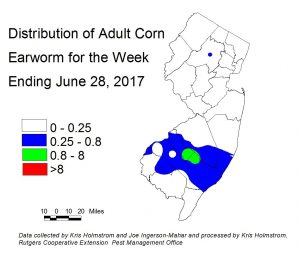 Corn earworm (CEW) moth catches decreased in the southern half of the state this past week. As we enter the latter half of June and into early July, we would expect only scattered catches of CEW moths. This is historically our CEW-free period. However, even very low CEW catches represent a threat where sweet corn is silking. At present, the highest activity remains along the Atlantic-Camden County border (see CEW map at left), although catches have occurred as far north as Morris County.
Corn earworm (CEW) moth catches decreased in the southern half of the state this past week. As we enter the latter half of June and into early July, we would expect only scattered catches of CEW moths. This is historically our CEW-free period. However, even very low CEW catches represent a threat where sweet corn is silking. At present, the highest activity remains along the Atlantic-Camden County border (see CEW map at left), although catches have occurred as far north as Morris County.
The highest nightly CEW blacklight trap catches are as follows:
| Elm 2 | Flanders 1 |
| Centerton 1 | Folsom 1 |
| Cinnaminson 1 | Medford 1 |
| Denville 1 | Pedricktown 1 |
Southern NJ CEW pheromone traps have registered lower catches this past week. This more conservative network is also indicating a similar threat level to last week (see CEW pheromone map below at right).
At present, the highest nightly pheromone trap catches are as follows: 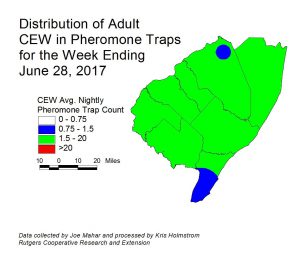
| Woodstown 8 | Pedricktown 3 |
| Pole Tavern 7 | East Vineland 2 |
| Berlin 4 | Elm 2 |
| Beckett 3 | Jobstown 1 |
Fall Armyworm
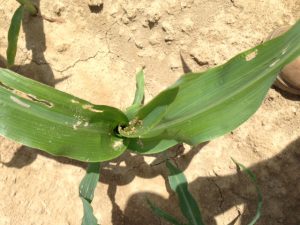 Fall armyworm (FAW) has arrived in NJ. Though infestations in whorl corn are few and very limited in scope, we should expect FAW to increase in the near future. This pest favors smaller whorl stage plants, and will even infest seedling stage plants if
Fall armyworm (FAW) has arrived in NJ. Though infestations in whorl corn are few and very limited in scope, we should expect FAW to increase in the near future. This pest favors smaller whorl stage plants, and will even infest seedling stage plants if the population is high. At present, low level infestations have been discovered in Cape May and coastal Monmouth County. This pest is capable of serious injury to plants, and scouting should commence immediately on whorl corn throughout the southern half of the state. Look for plants with “window-pane” type feeding that leads from the outer leaf surface down into the whorl (see photo at left). As larvae grow, this damage will progress to obvious ragged holes, with lots of caterpillar droppings in the whorl. The larvae are tan and brown (see photo at right), with a conspicuous upside down “Y” on the head capsule. If FAW alone or in combination with ECB are found to infest 12% or more plants in the sample, consider an insecticide treatment. FAW do not respond well to synthetic pyrethroid insecticides. In general, IRAC Group 5 materials like Radiant or Entrust (OMRI approved) or IRAC Group 28 materials like Coragen work very well on FAW and other caterpillar pests.
the population is high. At present, low level infestations have been discovered in Cape May and coastal Monmouth County. This pest is capable of serious injury to plants, and scouting should commence immediately on whorl corn throughout the southern half of the state. Look for plants with “window-pane” type feeding that leads from the outer leaf surface down into the whorl (see photo at left). As larvae grow, this damage will progress to obvious ragged holes, with lots of caterpillar droppings in the whorl. The larvae are tan and brown (see photo at right), with a conspicuous upside down “Y” on the head capsule. If FAW alone or in combination with ECB are found to infest 12% or more plants in the sample, consider an insecticide treatment. FAW do not respond well to synthetic pyrethroid insecticides. In general, IRAC Group 5 materials like Radiant or Entrust (OMRI approved) or IRAC Group 28 materials like Coragen work very well on FAW and other caterpillar pests.
Silking Spray Schedules*:
South – 4-5 days
Central – 6-7 days
North – 7 days
*These recommendations are based on regional catches.
Peppers
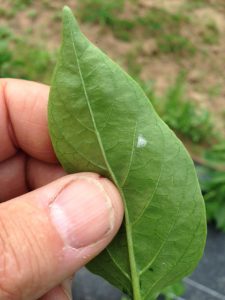 Pepper plantings in some areas continue to be at risk from ECB infestation, as moths lay eggs on the underside of pepper leaves (see photo at left). Larvae will hatch and bore into central stems of these small plants, causing the tops of the plants to die. While this is not terminal, it will prevent the production of crown fruit on affected plants. Scout 5 plants each in ten random locations. Check the underside of 2 leaves per plant. If 2 or more ECB eggmasses are found in this sample consider treating with a foliar insecticide or a soil applied insecticide such as Coragen. There are several options listed in the 2016-17 Commercial Vegetable Production Recommendations, including the OMRI approved spinosyn material, Entrust.
Pepper plantings in some areas continue to be at risk from ECB infestation, as moths lay eggs on the underside of pepper leaves (see photo at left). Larvae will hatch and bore into central stems of these small plants, causing the tops of the plants to die. While this is not terminal, it will prevent the production of crown fruit on affected plants. Scout 5 plants each in ten random locations. Check the underside of 2 leaves per plant. If 2 or more ECB eggmasses are found in this sample consider treating with a foliar insecticide or a soil applied insecticide such as Coragen. There are several options listed in the 2016-17 Commercial Vegetable Production Recommendations, including the OMRI approved spinosyn material, Entrust.
Pepper Weevil Update
No pepper weevils were trapped in the past week. So far as is known, there are no infested fields in the region.
Brown Marmorated Stink Bug
Blacklight trap catches of the brown marmorated stink bug (BMSB) have decreased to very low levels this past week, and no map will appear in this addition. It is important to note that late June and early July are typically the time our native brown stinkbugs become more active and will seek cultivated hosts. This is of increasing importance if dry weather degrades forage in areas surrounding fields. Scouting for stinkbugs in peppers requires stealth, as the bugs will retreat into the canopy if they perceive a threat. While scouting for other insects and diseases, approach each sample site slowly. Before disturbing the foliage to search for ECB eggs, aphids, etc., observe the upper canopy for the presence of stinkbugs. Often, they will bask on the upper leaves. If adults, nymphs or egg masses are found in 2 or more sites in a pepper planting, consider treating preventively to limit feeding injury to fruit. There are several insecticide options listed in the 2016-17 Commercial Vegetable Production Recommendations.
Pumpkins are now up in many areas. It is critical that these fields be scouted while plants are in the 0-4 true leaf stage. Striped cucumber beetle (see photo at left) is the most serious pest of these crops in this stage, not only because they cause direct injury to seed leaves and true leaves, but because at this stage, the beetles can transmit the bacteria that cause in bacterial wilt. Check 5 plants each in 10 random locations. If beetles are found actively feeding in 2 or more sites, consider an insecticide application to reduce the likelihood of bacterial wilt setting in later. Many pumpkin and winter squash seeds are purchased with a seed treatment that includes a neonicotinoid insecticide. In this case, cucumber beetle feeding should be seriously limited for the first 2-3 weeks of growth. This is typically long enough to get the plants close to the stage where vines begin to run or bush out. At this point, it is much more difficult for the plants to acquire a large enough bacterial load from the beetles to cause wilt. Organic growers of these crops should consider covering plants from emergence through just before vine run. This should limit beetle feeding and permit bee access to blossoms when the covers come off.
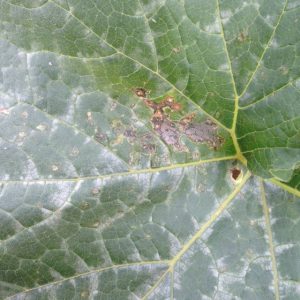 In addition, bacterial leaf spot (BLS) lesions have appeared in some plantings. This seed-borne disease is fairly common in pumpkin plantings, but growers with affected plantings should begin applying copper hydroxide materials to try to limit it’s impact. Older leaves are the first to become noticeably infected. Dark lesions will form, having water-soaked margins (see photo at left). These ultimately will dry and fall out.
In addition, bacterial leaf spot (BLS) lesions have appeared in some plantings. This seed-borne disease is fairly common in pumpkin plantings, but growers with affected plantings should begin applying copper hydroxide materials to try to limit it’s impact. Older leaves are the first to become noticeably infected. Dark lesions will form, having water-soaked margins (see photo at left). These ultimately will dry and fall out.
A cucurbit downy mildew (CDM) sentinel plot has been established at t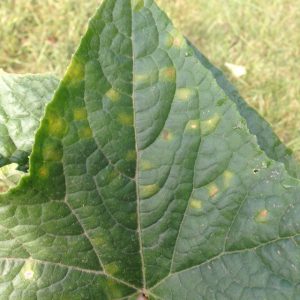 he Snyder Research and Extension Farm in Hunterdon County. This plot consists of cucumber, watermelon, cantaloupe, acorn and butternut squashes and giant pumpkins. This is just one of a network of sentinel plots in the eastern half of North America that will contribute information to the CDM forecast (http://cdm.ipmpipe.org/). An identical plot will be established at RAREC. These plots are scouted weekly for the presence of CDM. If found, the disease is reported to NC State Univ., the organization managing the forecast. Affected crops are also identified. The purpose of this is to provide early warning to growers of these crops so that they may react proactively to the disease, and treat the appropriate crops. A this time, it is important for all cucurbit growers to check the above website at least weekly for updates on the movements of CDM in the eastern U.S. CDM has been reported on cucumber in Maryland. The CDM forecast issued by NC State has NJ unaffected under the current conditions, however it is important to monitor all cucurbit fields (especially cucumber, is this host is the most frequent host) at this time. CDM causes yellow lesions to develop on the upper leaf surface (see photo at right). Lesions are confined within veins initially, but coalesce quickly to kill the entire leaf when moist conditions prevail. Beneath these lesions (lower leaf surface), dark gray spores will be produced. If discovered, please report any incidence of CDM to your county agent as soon as possible.
he Snyder Research and Extension Farm in Hunterdon County. This plot consists of cucumber, watermelon, cantaloupe, acorn and butternut squashes and giant pumpkins. This is just one of a network of sentinel plots in the eastern half of North America that will contribute information to the CDM forecast (http://cdm.ipmpipe.org/). An identical plot will be established at RAREC. These plots are scouted weekly for the presence of CDM. If found, the disease is reported to NC State Univ., the organization managing the forecast. Affected crops are also identified. The purpose of this is to provide early warning to growers of these crops so that they may react proactively to the disease, and treat the appropriate crops. A this time, it is important for all cucurbit growers to check the above website at least weekly for updates on the movements of CDM in the eastern U.S. CDM has been reported on cucumber in Maryland. The CDM forecast issued by NC State has NJ unaffected under the current conditions, however it is important to monitor all cucurbit fields (especially cucumber, is this host is the most frequent host) at this time. CDM causes yellow lesions to develop on the upper leaf surface (see photo at right). Lesions are confined within veins initially, but coalesce quickly to kill the entire leaf when moist conditions prevail. Beneath these lesions (lower leaf surface), dark gray spores will be produced. If discovered, please report any incidence of CDM to your county agent as soon as possible.
